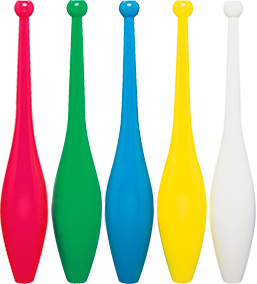Did you know that dumbbells were once exactly that? They were bell-shaped weights designed to let bell ringers exercise without keeping the whole village awake.“Dumb bells”
Indian Clubs are something that has interested me for some time. The current name probably originated with the Victorians. Club-shaped weights had been used in India to train wrestlers and other athletes. The British Victorians were very familiar with India and many of them were interested in sports and fitness. One of the reasons the Indian club was of interest was that it was a very good device for sword training. To have a whole troop or squadron of cavalry recruits swinging swords about needed lots of room and was potentially lethal. Using Clubs needed less room and any likely injuries were easier to treat. A bonus was that the club could be made a little heavier than a sword, making handling an actual sword faster and less tiring. It is possible that most sword using cultures had something like the Indian club but what they were called before they were called Indian Clubs I don’t know.
Recently I have been attempting to trade some of my body fat for muscle, which has been going very well and has proved easier than I expected. My girlfriend has taken to buying me smaller tee-shirts so she can show me off. It wasn’t long before Indian Clubs entered into my exercise routine. Indian Clubs are a very good first exercise. Their relatively moderate weight means they are a good warm-up and the swinging action is very good for opening up the chest and expanding the lungs ready for further exertions.
If you try to buy Indian Clubs you will probably be in for a shock. Both antique and modern examples are sold at very high prices. Another problem is that many of the examples you will see are too heavy for a first time user. Clubs have a lot of leverage and momentum working for them so generally you want a club of under four pounds for single-handed use.
The solution is to make your own Indian Clubs! This is actually very easy to do. Look on-line for a set pair of plastic juggling clubs such as these.

Once they have arrived you will have to fill them. What you use will depend on what you have available. If you live near a beach use sand. Mine got filled with potassium chloride salt since there was a load of it going spare at work. This has fused into a single mass inside the club which suggests materials such as cement or Plaster of Paris might be good choices for fillings.
Cut off the top of the Clubs or bore a hole, fill with the required weight of filling and reseal. I used high strength epoxy, a generous length of electrical tape and varnished it for good measure. A more elegant approach would have been to drill a hole and seal over it using plastic from a container such as a shampoo bottle.
An alternate approach would have been to use suitably shaped plastic bottles. These have the advantage that you can fill them through the bottle neck. The complication is that you will needed to improve the what will be the butt of your club so it does not slip from your hand and take out a window. One way to do this would be to acquire something like a pair of golf balls. Drive a woodscrew up through the bottle cap, smear it with glue and screw the golf ball down onto the screw until it contacts the cap. Smear the threads of the cap with more glue and screw it in place on the bottle. Wrap with a foot or so of tape for good measure.
You now have a pair of Indian Clubs for a fraction of the price you could have paid! With the money you saved you can buy a copy of my book!.




